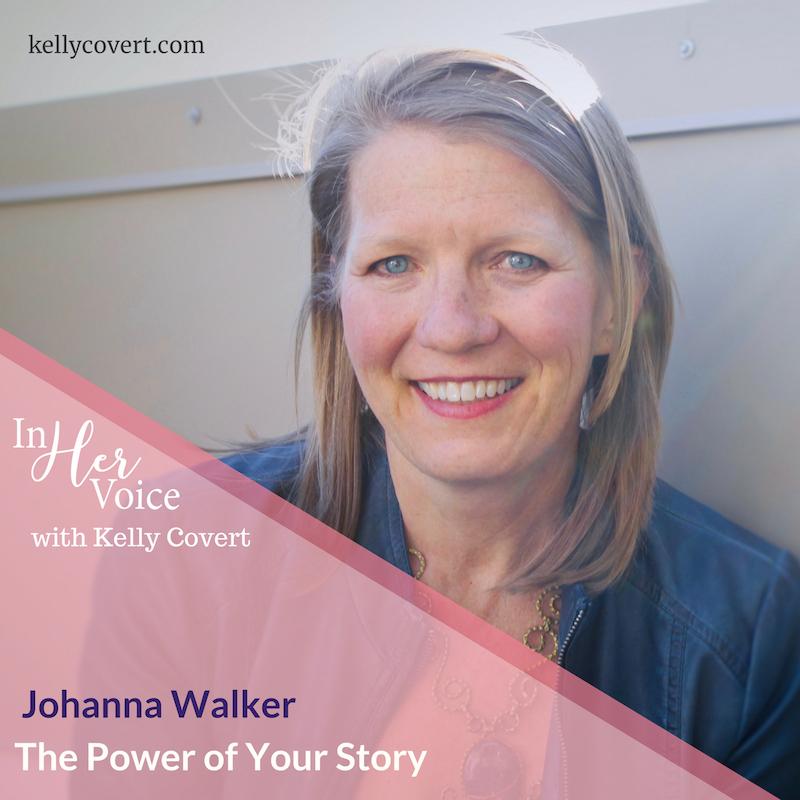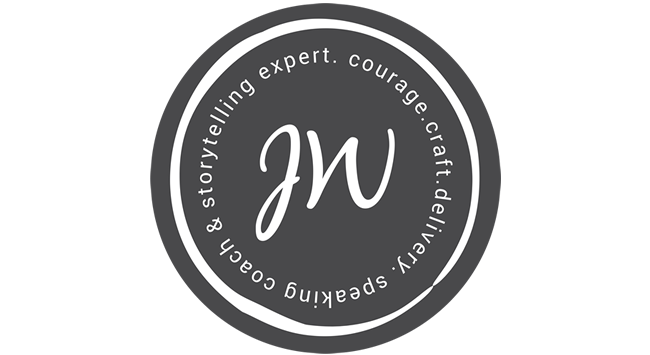
Speaking for Yourself
May 10th, 2019


| A client recently came to me with a big confession. She wrote in an email, “Johanna, I have to confess…my primary motivation for speaking is not to help people. I do want to help people. I do want to have an impact, but mostly I want to help myself. I want to be taken seriously. I want to feel respected. I want to find my smarts.” Here’s what I wrote back: “It’s TOTALLY OK to want to speak to help yourself.” Speaking is a powerful transformational tool. It can change other people AND it can change you. I believe it takes you so far into your core stuff, and making the decision to do it can wake up power you didn’t even know you had. When you do that for yourself, and you let yourself be changed, it impacts other people. Even if your main goal is personal transformation, it will help other people.” ~~~ If you’ve been around these parts for a while you’ve probably heard me quote JFK saying, “The only reason to give a speech is to change the world.” So yeah, the people in your audience will be changed by your talk. That’s what we’re after. You have an idea, a story, a kernel of truth you want to share. When someone in the audience hears it, they’re changed, and they go live their life differently AS A RESULT of your talk. You definitely don’t want to leave the audience out of the picture. But change happens in so many ways! On so many levels! One of the big changes is YOU. YOU will be changed by speaking. To go through the process of digging for your what it is you truly want to say, crafting your ideas into a talk, getting that talk up on a stage, taking a risk, stepping outside of your comfort zone in a slightly uncomfortable speaking situation, it invites you to CALL UP YOUR POWER. The wonderful thing is that once you call it up, IT’S YOURS. Of course there will be new journeys, and new risks, and new power to call up, but each layer you discover is yours for the keeping. ~~~ I was at the Womxn’s March in Denver last weekend, and I remembered having heard Holly Near speak at a rally many years ago. She told a story of protesters on her campus during the Vietnam War. She would walk past them every day and think to herself “What good is that doing? It’s not changing anything.” Then one day she stopped and stood with them, and showed up day after day to stand on that street corner with them. What she noticed was that she was changed by standing with them. Whatever the impact her protest had on the big world picture, the change that happened inside herwas significant. We are changed by the actions we take. When we allow ourselves to be changed, we move in the world differently, thereby changing the world. I believe that’s true for speaking, too. Speaking will change you. So, whether it’s showing up for a march, or taking a stand for something you believe in, or getting on stage to speak your truth, or speaking bravely in a difficult conversation, or raising your hand before you feel ready to speak… I invite you to show up, walk to your own personal edge, take action in the direction of the thing you want, the thing you care about, and then allow yourself to be changed. I know the world will be a better place as a result. |
Be Yourself?
April 16th, 2019

One of the things I talk about with my clients all the time, and you probably hear often from business coaches (and speaking coaches and life coaches and inspirational leaders and middle school teachers and self-help books and best friends and anyone who has anything to say to anyone about how to make sense of the world) is—
Always be yourself. Be true to you. Stay authentic.
If you’ve got a business, bring more of you to your business.
Speaking? Bring more of you to the stage.
When you’re wearing the marketing hat, bring more of yourself to your marketing.
You get the idea.
If you can’t be you, why bother doing it at all?
But I will also say, sometimes that’s easier said than done.
I remember even as a teen reading “Be yourself” advice in teen magazines and thinking “But what does that even mean?”
When you’re figuring out who your SELF is as a teen, in the crowd of other teens figuring out who THEY are, being yourself can seem like a rather daunting project.
And besides, what if people don’t like who you are? Yikes.
I’d say the same goes for a business owner, or a speaker. Figuring out who your “Self” is as a business owner/speaker can take a bit of time. With every new challenge and every new opportunity we find a new “self” we didn’t even know we had.
When I started my coaching business 6 years ago, I certainly felt pretty uncomfortable in my new-business-skin. It was like a whole new piece of clothing I had to figure out how to wear. I wanted to wear it so that it looked good on me, but more importantly so that it was comfortable to live in.
Buuuuuut, comfort doesn’t often go in the same sentence as growth.
I talk a lot about the value of discomfort, and how comfort isn’t always the goal.
Sometimes, in fact, discomfort is the goal.
Not discomfort for the sake of discomfort, but discomfort for the sake of growth.
When we’re willing to show up for discomfort, we grow into new skin, and find a new layer comfort, a new layer of our SELF that we didn’t know before.
And then BOOM! Another layer of discomfort…Hec that’s a never-ending process.
Stretch, discomfort, growth, comfort, stretch again…
I’m musing on this because one of the places I’m super uncomfortable being visible is on social media. I grit my teeth and do it, but I don’t love it. Give me a stage and a mic any time, but virtual visibility? Ugh.
Except, I’ve recently been finding meaningful engagement over on LinkedIn. It never occurred to me that there was much going on over there that could be of interest to me. But I love it!
Here’s what happened: I was doing my best to tuck in and play the game of looking like every other professional out there, when I saw someone else being visible as her unique wacky self, and doing it on LinkedIn, and I thought “That looks fun! I wanna do that!”
So I did!
I decided to bring more of my wacky self forward and see what happened.
And it was fun! Fun because I got to be uncomfortable being visible, and then watch myself grow into new skin.
Fun because it also brought some haters. Ok that was a tiny bit ouchie, but mostly it was fun because—I got to say, “Hey. You’re not my people. Thank you very much. I’m not your gal.”
And that’s fun.
Also fun because it opened the door to more engagement. Meaningful engagement with people who saw ME and said “Hey I want more of THAT”
That’s what happens when you show up as You. All the way.
You attract the people who want YOU.
Even if you’re still figuring that out as a business owner, as a speaker, as a human, every reach into that uncomfortable place of visibility is gonna show you a little bit more of who you are.
Here’s the video I posted on LinkedIn.
It’s 3 minutes. Watch it to see me bringing my wacky self to LinkedIn.
But also watch it because it shares a tool you can use to bring more of YOU into the room, in spite of whatever nerves or limiting beliefs or caution has kept you hiding and tucked in.
Drop a comment on the LinkedIn post, and if we’re not already connected, let’s connect on LinkedIn.
Let’s BE OURSELVES and have some fun!
Creativity is where it’s at
September 17th, 2018
 I often say creativity is not just reserved for artists. It’s a birthright. Simply by being alive and human we are creative beings.
I often say creativity is not just reserved for artists. It’s a birthright. Simply by being alive and human we are creative beings.
Some people hone it more than others. Some people’s creativity gets squashed, but we’ve all got access to it all the time.
That’s what I talked about with Melissa Dinwiddie on her Creative Sandbox Podcast. We had a great conversation about how creative play can help us access more power in our voices.

In this episode we talked about:
- How I became a fear-blasting, story-telling maven for entrepreneurs and people with a mission
- How we teach what we need to learn
- Our personal experiences with becoming comfortable on stage & sharing our stories
- How connecting to my body through dance helped me to connect to my speaking voice
- The open door that the play state creates for both of us
- How fear is a learned pattern that originally served us well, and that is no longer serving us.
- How creative play shakes those patterns loose and turns the fear into useable energy
- Stepping through the doorway of fear
- The power of our stories in others’ lives
- Creativity being most powerful when there’s a clear container for it.
Have a listen!
Here are some quotes from our conversation:
“I was pretty good at figuring out what the right answer was, so I would deliver the right answer or if I wasn’t 100% sure I had the right answer, I stayed quiet.” – Johanna Walker
“Connecting to my body through dance was a huge way of connecting to my voice and my power.” – Johanna Walker
“You can’t be in fear and be in that play state at the same time.” -Melissa Dinwiddie
“When we’re in that play state, we get our full, authentic selves to show up.” – Melissa Dinwiddie
“Play is bigger than fear. Play is stronger, it is more powerful than fear. Play is mightier.” – Johanna Walker
“Fear is energy. It’s a story we have in our head, but when we can let go of the story, drop into our breath, and our body, and our voice, then the fear is no longer a story it’s just energy and we can play with it.” – Johanna Walker
“We think that they [our stories] don’t matter, or it’s just about me, or it’s too weird, or it’s too dark, or it’s too personal, or there’s some reason not to tell it, but when you can really get that it’s not about me, it’s a gift, then it’s just like here we go.” – Johanna Walker
“The more clear the limitation is [on my creativity] the more room is for me to push up against the edges and feel my fullness and push the edges out a little.” – Johanna Walker
What’s the power of your story?
September 17th, 2018
 Do you know the power of your own story?
Do you know the power of your own story?
That’s what I talked about last week with Kelly Covert, the host of the podcast In Her Voice.

In the interview, we chat about:
- How you can take the power away from the voice that tells you “I don’t matter”
- Why a powerful story doesn’t have to be traumatic
- What question to think about as you craft your story
- My advice for you as you become a storyteller
You can listen to the interview by using the player below, finding it on your favorite podcast app, or by clicking this link.
FREE CLASS August 21, 2018
August 14th, 2018
How to become a sought-after speaker
August 14th, 2018


I was recently asked by a potential client “Will you be able to get me to the point of becoming a sought-after speaker?”
Part of me wanted to jump and say “Absolutely! Work with me and I promise you’ll become a sought-after speaker! I can show you the pot of gold at the end of the rainbow! All your dreams will come true if you work with me! I have all the answers to all your questions! Your life will never be the same!”
But of course I didn’t. That’s not my jam. I’m more inclined to say there’s a chance you won’t become a sought after speaker.
Building a speaking business is HARD WORK. It takes determination. It takes a ton of resilience and get-up-off-the-floor-and-do-the-next-thing Commitment with a capital C.
It’s no walk in the park, and there are no guarantees.
Since that conversation I’ve been thinking about what it takes to become a sought-after speaker.
Here’s what I came up with. Four things:
EPIC CONTENT
NETWORKING
PITCHING
KNOWING IN YOUR BONES THAT YOU’RE THE BOMB AND WORTHY OF SPEAKING ON ANY STAGE YOUR HEART DESIRES.
Let me say a few words about each of these:
1: EPIC CONTENT
Yep. It all starts here. You gotta have top notch, content-rich, story-laden, audience-serving, out-of-the-box, well-crafted, from-the-heart (the hyphenated words are really workin for me here…)
EPIC. CONTENT.
Basically, you gotta have a great talk.
A talk that moves audiences to action, comes from your expertise and heart, takes your audience on a clear path from here to there, leads them to walk out of the room changed, so much so that they TALK ABOUT YOU.
You gotta have a talk that is fun for you to deliver, that keeps you on your toes. A talk you know in your bones, that awakens something in you, something that brings new life into the room when you speak about it.
A talk that conveys the heart of your message, and touches the heart of what your audience longs for, that find the meeting place between those two things.
With a clear pathway to transformation the moment they walk out the door. Boom. Epic Content.
2: NETWORKING
During the getting booked portion of Women Who Speak, my speaker mastermind for women leaders, one of the first steps I ask participants to take is to publicly identify as a Speaker.
In social media profiles, on websites, in conversations. Let the world know you have something to say that you want people to hear, and you want them to hear it on stages they invite you to speak on.
Not just event producers, but friends, neighbors, colleagues. Introduce yourself as a SPEAKER. That’s a starting place.
Then, find out where your audience hangs out. Go to conferences and events where you want to speak. Make yourself know to the people who run those events.
Be generous. Build real relationships. Connect people to other people who you think could serve them.
Put yourself out again and again. And again. Be visible.
When you speak, stay connected to the people who invited you. Be a speaker they want to bring back. Be a speaker they want to refer to other events producers. Be a speaker their audiences talk about.
There you have it. Networking in a nutshell.
3: PITCHING
I suppose there might be some people out there who never had to pitch a talk, and who, right from the getgo, had people knocking down their doors to speak.
If you’re one of them, great.
If the vision you have of the speaker you are is the one that means you get to sit home on the couch eating bonbons, knowing that someone will call upon your genius and bring you to their stage and make you a sought-after speaker, then yay for you.
I fully support you in that endeavor.
But as far as I can see, to become a sought-after speaker, you gotta put yourself out. You gotta ask. Relentlessly. You gotta pound the proverbial pavement.
Event producers are not sitting at home with nothing to do waiting for your call. You have to find the events where your audience hangs out. Find out what they want. Find out why they come to that event. Find out whether your message will truly serve them.
You have to do your research. You have to pitch, then pitch again, then pitch again. And then again.
You have to sell yourself. Not sell yourself out. Or sell yourself short. Or sell a pumped up version of yourself. Or sell in any way that compromises your integrity.
But you do have to sell yourself and your big idea.
You have to communicate to the event producer that something you have will benefit their audience in a big way.
That’s what I’m talking about. Pitching.
4: KNOWING YOU’RE THE BOMB
In order for any of the above steps to be successful in leading you to becoming a sought-after speaker, you gotta know you’re the bomb.
Speaking will bring to the surface any gunky, murky, self-doubting, second-guessing, self-flagellation that’s lurking under the surface.
If you don’t clean it up, it will ooze out of your pores. It’ll show up in your voice and in your face.
I’m not saying you have to kick all that to the curb before you put yourself out. I’m not saying you have to WAIT till you clean all that up before you begin. No way.
In fact, in taking action towards becoming a sought-after speaker, you will clean a lot of it up. You will move a lot of it out.
Taking action, which also means taking big leaps into unknown territory, is the number one thing that will bring that gunk up from the buried nether lands, and, if you meet it when it arises, it will come up and then it will keep moving right on out.
Yes it will be uncomfortable.
Yes it might be scary.
Yes you might want to run.
But if you take action, and look right in the eyes of the self-doubting, procrastinating, second-guessing demons that are trying to keep you small, if you maybe even invite them to tea, the inner transformation that will happen as a result will look something like
KNOWING YOU’RE THE BOMB AND WORTHY OF SPEAKING ON ANY STAGE YOUR LITTLE HEART DESIRES.
THAT’s what will make you a sought-after speaker.
There. That’s it. Epic Content. Networking. Pitching. Knowing you’re the bomb. You can’t have one without the other. Or rather, one without the other won’t quite get you there.
But with all 4, you’ll be a quadruple threat.
Which one needs a tune-up in your speaking journey?
What should I do with my freakin hands?!?!
July 5th, 2018


Photo by Chang Duong
When I got rolling on my newsletter habit this spring, I made a list of questions people often ask me.
One question on the list was “What should I do with my hands?”
So I sat down to write the newsletter and wrote this whole intro about how people ask me that question all the time. Then I realized… wait a minute. Do they? Actually, not so much. My clients generally have bigger fish to fry, and aren’t really worrying about their hands.
But sometimes when I watch speakers, I put my coaches hat on and think maybe that should be a question they’re asking.
So…since you asked…. 🙂
Most of us are not terribly conscious about what we do with our hands & arms. Your hands just do what they need to do to get the job done. They cook and dig and hug and touch and write and type and clean and open car doors and carry groceries and hold babies and so much more.
But when you get up to speak, suddenly they become these long appendages just hanging from your shoulders, entirely cumbersome, in the way, over-busy or wanting to hide. You might become hyper aware of them and flail them about, or maybe you’d rather just leave them at home. All of a sudden they become something you have to figure out what to “do” with.
Your hands and arms are one of the key places where unconscious speaking habits set up shop–and disconnect you from your speaking power.
So when the sudden light of awareness gets shined on these long and rather awkward appendages, your hands and arms fall into habitual patterns as a sort of safe landing pad. A comfy groove. Something you can put on auto-pilot while the rest of you faces the crowd.
There are the flailing hands
the fingertip-to-fingertip hands
the thigh slap
the jab the air repeatedly
the repetitive gesture
the pocket hide-out
the protecting-your-naval folded hands
the protecting-your-crotch folded hands
…to name a few.
If any of those patterns sound familiar–as in YOU DO THEM– you’re not alone. They’re just patterns, and like any pattern, they can be changed. With awareness and attention and practice, you can create new grooves so your hands, your arms AND YOUR TALK become fully integrated with your heart and your message.
Here are 5 ways to enliven and awaken your hands
so you can access their full expressive power, and they can support your talk rather than distract from it.
1. Your hand is an extension of your heart. Your open hand is a direct through-line from your heart to your audience. Draw a line with your hand from your heart, down your arm to your other hand and back again. When you’re speaking, your audience gets connected to this line. Your hands actually serve as a way to let your audience into your heart.
2. Connect your spoken pauses to your gestural pauses. When your speech pauses, pause your gesture. When your gestures pause, pause your speech. This can help bring more awareness to the space you take when you speak, helping you slow down and bring mindfulness to your hands AND your speech.
3. Notice what you do with your hands off stage, when you’re talking to someone you care about, or telling a story, or sharing something you’re passionate about. Notice what your hands do when you’re not “speaking” and take note of what they do naturally. There’s probably a clue there to what to do with your hands when you are speaking.
4. If you notice a repetitive, habitual gesture, DON’T DO IT. When you’re practicing your talk, do one round of practice that is fully focussed on your gestures. If you catch something that you do in a repetitive way over and over again, bring your attention there and just DO SOMETHING ELSE. This will probably feel awkward at first, and is certainly easier said than done, but super important to muddle through the awkwardness in service of new patterns & pathways.
5. Do your homework. And come to the Speaker’s Playground! In other words, it takes practice. In order to create new pathways, you have to get uncomfortable for a while, and practice new pathways over and over again. But the pay-off is huge. (Here’s a link to the FREE CLASS I’ll be offering on July 31.)
Trust me on this. What you do with your hands can make a huge difference in helping you feel grounded, connecting you to your audience, conveying the power of your message, and communicating your care and passion for your message.
Stand up right now and open your arms wide, palms forward. Imagine your heart opening through your hands. Let yourself take up space. Breathe into your heart. Breathe into your hands.
Now smile, and delight in knowing just what to do with your hands.
See you out there!
How to stop saying UM once and for all!
June 21st, 2018


Are you an ummer? Or is “ah” and “uh” more your style? How bout “so” and “and?” Do you want to stop saying “um” once and for all?
First, a quick story. When I was in middle school, I was at a church youth group meeting listening to one of the older girls gave a talk, sharing her older-girl wisdom with the younger girls. At the end of her talk I raised my hand and said, “You said ‘y’know’ 36 times.”
I guess I got started early as a public speaking coach. 🙂
When I first hung my shingle as a grown-up public speaking coach, I thought, “Yeah…. whatever. A few ums is no big deal. I’ve got bigger fish to fry. It’s more about the heart of your message, the story you tell, how you show up, and the connections you make with the people in your audience.”
And true, it is.
BUT the ums (and ahs and uhs….and sos and ands and y’knows and likes and all those other sounds & words we use to fill the gaps) are major impediments to connecting with your audience. To getting your message across. To staying fully present in the room as a powerful, impactful speaker.
If your speaking is sprinkled with filler words, your audience has to do the work of filtering through those fillers to get to your message.
We’ve been working on THE UM THING in recent sessions of Speaker’s Playground. What I’m learning more and more is that doing this work touches on all aspects of becoming a more powerful public speaker.
When you stop saying um, it allows the audience more space to actually hear your message and integrate what you’ve said.
Your presence becomes stronger and clearer when you let all the fillers go by the wayside. Then YOU become the powerhouse in the room, and everyone leans in to hear what you have to say.
(I’m using um to stand for all filler words, so if um isn’t your thing, but starting sentences with so or and is, then stay with me!)
OK but how do you stop using filler words anyway?!
Here’s how:
STEP 1. BE AWARE
Being blissfully unaware might work for a little while, but once you start finding ways to eradicate the ums, you’ll see how powerful your speech can be without them.
After blissfully unaware comes ridiculously-stilted, self-conscious, stumbling awareness, where the only thing your brain sees is that big glaring UM that you’re trying so hard not to say.
Which means it’s possible that paying attention might even make you start saying more ums at first. Yuck. Who wants that?
But if you stay through the self-conscious phase (where you’re thinking about it constantly and it’s driving you mad) you will find yourself on the other side in the integration phase.
In the integration phase, the new groove in your brain has been formed and ums don’t slip in. Or at least you have enough agency and awareness to make a different choice when they try to slip in.
So find a way to track your ums. Ask a friend to be your “um-dinger” next time you give a talk. Turn on your phone and record yourself speaking. Watch a video of yourself speaking.
You might not realize how many filler words you’re using. Once you start noticing, rather than um-bashing yourself, celebrate that you’re now aware, and start working to create space for a pause instead of an um!
STEP 2. SLOOOOOOW DOOOOOOWN
Waaaaay down. Go slow enough to catch the ums. Slow enough so your words aren’t pouring out of your mouth faster than your brain is thinking. Slow enough to make a different choice when you feel the um coming.
It’s ok to pause. It’s ok to take a moment and think about what you’re going to say next. (Check out another post THE POWER OF THE PAUSE, and all the different ways to integrate pauses into your speaking)
Your brain might get tripped up here. When you feel the um coming, you might pause, and then all your brain can see is that glaring um that it’s trying so hard not to say.
That’s ok. Just hang there for a minute. The um will dissolve and you’ll get back to your message, even more clearly, even more powerfully, with you even more fully in the room.
Just. Slow. Down.
STEP 3: RISK CONNECTION
One of the things we discovered in Speaker’s Playground recently is that in that space where the um isn’t happening, there’s room for connection, for my humanity to touch yours.
Which can feel mightily uncomfortable. At the same time that it’s exactly what we’re after when we’re speaking, right?
I know pausing can be one of the scariest things on the planet. A pause means you have to actually be present with yourself and your audience and potentially feel whatever fear or discomfort you might be having inside.
But the pause is where it’s at.
If you’re not saying um, you’re bringing yourself into more mindful presence. You might find yourself in a state of “I don’t know.” You might feel a little lost for a moment.
And who’s there to find you but your audience!
So when you have that impulse to push away the discomfort, close the gap, run away and say UM, hang right there, with the discomfort of not knowing, of actually sensing and allowing what’s happening in your body, slowing down enough to breathe, noticing your audience is there to be with you.
Yikes, indeed. But that’s exactly when real connection happens. And is way more satisfying and fun than saying um. 🙂
STEP 4. WORK THAT MUSCLE!
Eradicating the ums is a practice. By paying attention to it, you will strengthen that muscle and create a new pathway, a new groove.
A concert pianist practices scales over and over, but when she gets on stage, she is connected to the heart of the music, to her audience, to the magic of what’s inside the music. She’s not thinking about scales. But you better believe she’s done them.
Doing um-dinger practice is like doing scales. Or lifting weights. Or running hill sprints. It is a muscle that takes focus and attention to strengthen. It can be hard work. And it’s totally worth it. (Want practice support? Come join us in The Speaker’s Playground!)
The more you bring your awareness to it, the more you work that muscle, the more easeful it will become to catch those fillers and make a different choice right there in the moment of speaking, bringing more of your powerful presence to the stage.
Have fun, and let me know how it goes!
Your story matters!
June 14th, 2018


- It’s not about you—it’s about your reader, your listener
- Yes it’s about your reader, but YOU ARE A FREAKIN GENIUS (yes you) and your readers (or listeners) are waiting to hear what you have to say.
- What you have to say matters. (Really. It does. To someone it will make a big difference, even if not to everyone)
- And, riffing off one of the rules in the Speaker’s Playground: Go before you’re ready and you will find out what you have to say simply by saying it
Protected: Webinar Replay
June 9th, 2017

FOLLOW ME